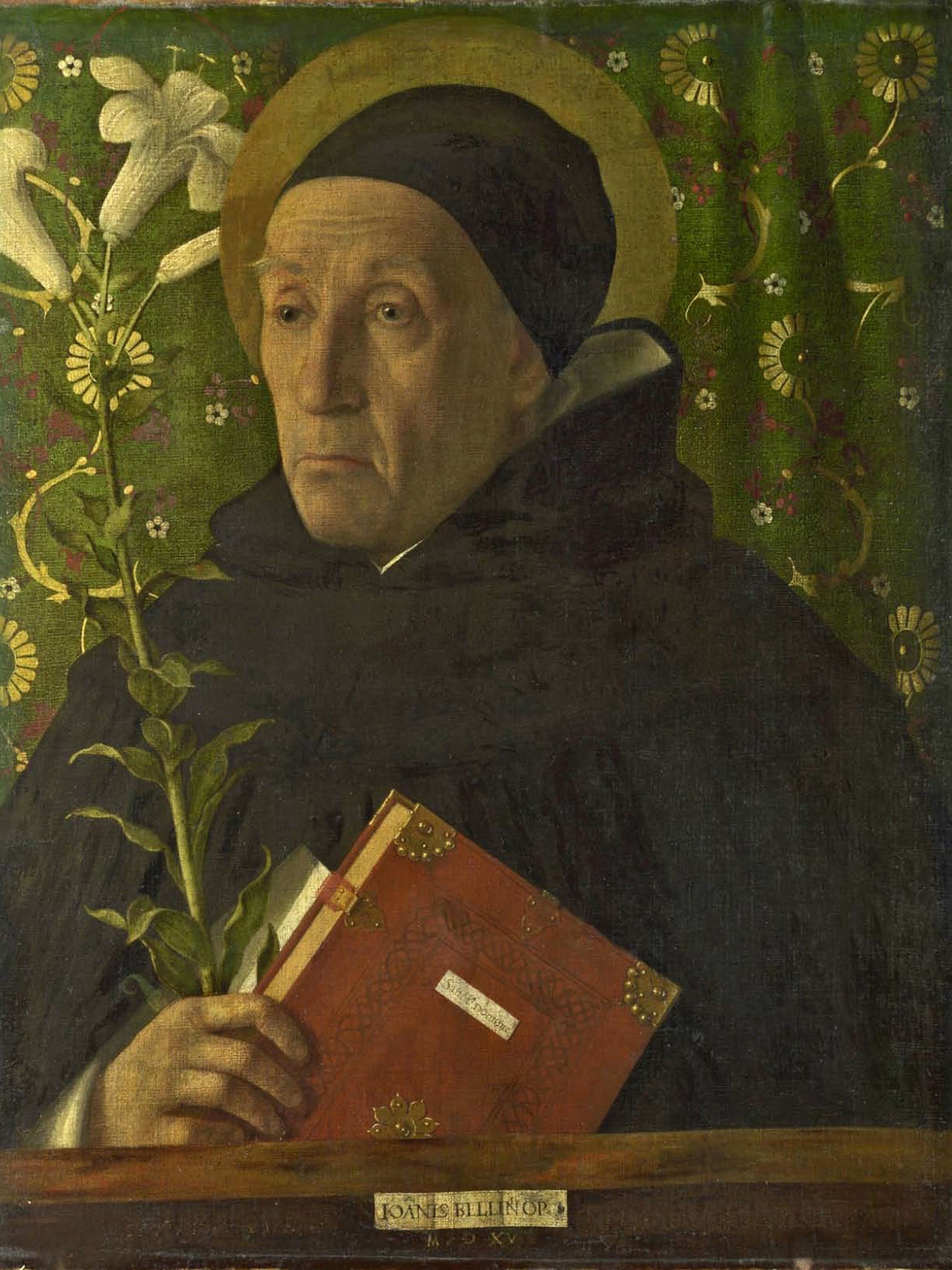Great Works: Fra Teodoro of Urbino as Saint Dominic (1515), 63.9 x 49.5 cms by Giovanni Bellini
V&A Museum, London

This likeness of an elderly Venetian friar who may have lived in a convent near Giovanni Bellini's own home in the sestiere of Castello was the last portrait that the great Venetian painter was known to have executed.
We can read the date of it – 1515 – relatively distinctly on the marble balustrade directly beneath the characteristic trompe-l'oeil signature of the painter himself. The painting is heavy with symbolism – as if to over-emphasise his piety, the friar is clasping in his right hand both a book inscribed with the name of Saint Dominic and a lily – which would have required some degree of dexterity.
Here is the matter which intrigues us most. Is this a portrait of a saint or a portrait of a man? It is perhaps a little of both. The lily and the book were attributes of the saint himself. You could call the way they are thrust at us slightly excessively pedagogical – the title of the book is attached, unusually, to its back, in order that we shall be quite clear on this point.
The habit the friar is wearing is that of a Dominican, complete with its snugly fitting black cap. See how the white V of the scapular peeks out directly beneath the slightly projecting chin. The cap and the scapular serve a very useful visual purpose. They frame the face, and help to project it forward as the object of greatest visual interest to the onlooker. The lily is a real painted lily, but the way it melds back into the patterning of the curtain behind it, thereby inclining us to regard it as more of a decorative than a symbolic object, slightly reduces its aura of sacredness. And then there is the face itself.
Bellini may have known this man – there was a friar registered at the convent of San Giovanni e Paolo in 1514 called Fra Teodoro of Urbino. This may be that man. What is more, it may be that the Friar is posing as the saint in order to identify himself that much more completely with the founder of his order. Or it may be the friar as the man himself, wearing the habits of his order, showing off his devotion. Or, as the title seems to suggest, it may be a portrait of the saint, modelled by this friar. Three possibilities, then, and all kept in a kind of bewitchingly delectable balance.
He is utterly individualised, this friar, ascetic yet robustly present – there is nothing abstracted or generically saintly about this face. The eyes are fixed but filmy; the eyebrows – like the eyebrows of so many older men – take wing. The lips are pursed, the mouth downturned. The spinning halo seems to be in conversation with the metal quarter moons set at the corners of the book of sacred writings.
There is an instructive comparison to be made between this work and Bellini's portrait of Doge Loredan, also in the National Gallery, and painted a little more than a decade earlier. That portrait too is cut off mid-torso, but its plain blue ground makes it seem both less immediately present to us physically and more remote as a human being. It is smallish within its frame, and somewhat set back. The Friar is more immediately present to us. In fact, he is almost crowded into our presence, nudged forward by the fussy presence of the curtain at his back. The fact that this curtain has clearly defined folds gives it vigour, active virtues. Had that not been the case, it would have played a more humble, supportive and unassuming role.
The cool, brilliant blue at the Doge's back has its own staginess, but its effect is to make him seem somewhat remotely imperious. What is more, we see nothing of the Doge's hands. He is a little like a rather triumphal Roman portrait bust. That too would generally have ended mid-chest. Had Bellini shown the Doge's hands, we might not have been reminded of that link with the greatness of the Roman Empire.
The friar's clasping hand is important. It makes him seem actively engaged in his faith, as warrior, thinker and bearer of the sacred attributes. The Doge is presented to us head-on, the friar in three-quarter view. Their looks are slightly askance. Since the Middle Ages, it had been customary to present sacred portraiture face-on, so the presentation of the Doge in this way was a radical step – and a way of emphasising the symbolic importance of the man. The friar is utterly present to us, both as himself and Saint Dominic. Saint and sinner in one.
The portrait is currently on display in Room 61 at the National Gallery, London WC2
About the artist: Giovanni Bellini (c.1430-1516)
Giovanni Bellini (c.1430-1516) was the greatest of a great family of Venetian painters, which included his father Jacopo and his brother Gentile. His brother-in-law was another great painter, Andrea Mantegna. Having grown up in his father's house, he left for Padua at the age of 18. By 1560, he had returned to Venice, and would work there for much of his later life, creating sacred images for churches, decorative schemes for the Doge's palace and a great deal else.
Subscribe to Independent Premium to bookmark this article
Want to bookmark your favourite articles and stories to read or reference later? Start your Independent Premium subscription today.

Join our commenting forum
Join thought-provoking conversations, follow other Independent readers and see their replies